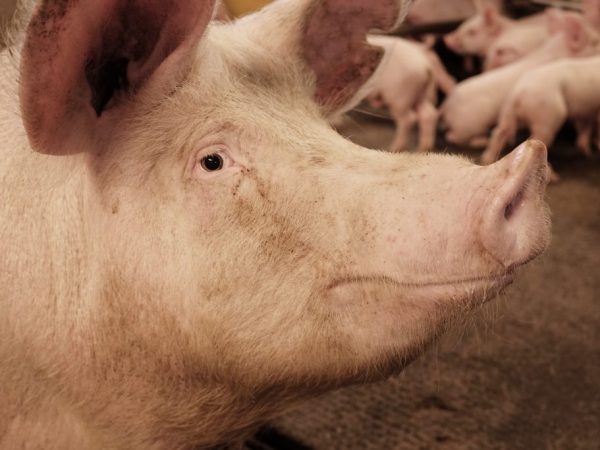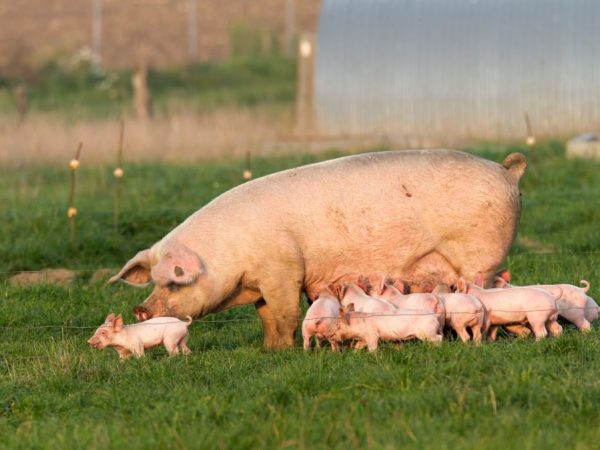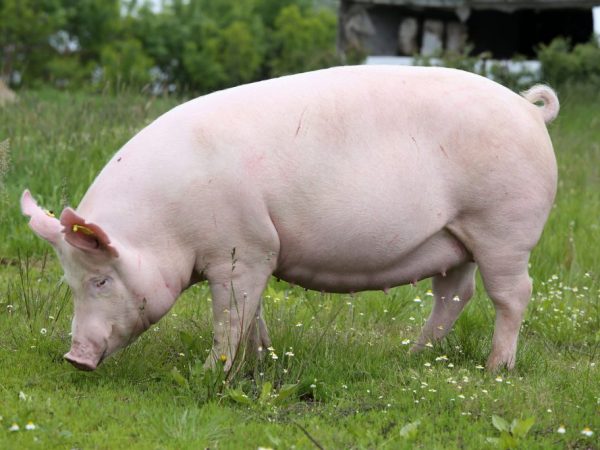Sow maintenance and care
Successful and profitable animal breeding is only possible with quality offspring care. But before the offspring appear, it is necessary to provide the necessary maintenance for the breeding stock, in particular, for females. And pigs are no exception in this regard. Only a healthy sow can provide healthy offspring. And it is not only the quality of keeping pregnant breeding sows that is important. You need to properly feed and care for them also in the period before fertilization or childbirth.

Sow maintenance and care
Sows maintenance
To understand how to keep sows, you need to figure out what periods of her maintenance is divided into. Without this useful knowledge, it will not be possible to provide proper care for each of the queens. And in order not to destroy animals with your own hands, you need to understand exactly how they are kept, and according to what principles. There are two main methods of content - individual and group. In this case, it is necessary to decide when and how to apply each of these techniques. It all depends on the state of the animal:
- Sows that are single or in preparation for mating are kept together with the entire herd. At the same time, in one corral there cannot be more than 10-12 heads, and each should have 2 square meters of area. Or they are kept in pens for artificial insemination.
- Pregnant females. The gestation period is divided into two main stages, and during this time the female is usually kept with the rest of the herd. Although, if there is such an opportunity, the uterus is kept separately during the second period. Pregnancy should be calm to avoid miscarriages. The pregnant uterus is kept in a pen, where she is allocated 2.5-3 square meters of area.
- Sows during labor and suckling sows. While the female is with the piglets, she should be kept separate from the rest of the herd. And the birth itself should take place where the pig will not be disturbed by other animals. Sows and small piglets are kept separately from birth. This will help to ensure normal feeding and development of the babies.
Separately, it is worth talking about how pregnant sows are kept in group care. In medium and large farms, pregnant animals are kept in a separate enclosure for convenience when feeding and keeping. At the same time, they try to keep together those females who have the same term of birth. Of course, it won't work perfectly, but the match should be within one month. Then it will be easier to plant them on time, as well as provide them with a suitable diet. But it is still worth noting the approximate delivery date of each pig.
How does a sow's sexual cycle proceed?
What else a farmer should understand is how the sexual cycle in sows proceeds.Then he will know exactly when the time comes to cover the pig, and how exactly to do it with maximum efficiency. First, you need to figure out when the pig ripens, and how often the hunt takes place. And then it is already necessary to disassemble all its main features, by which a given period is determined. Without this, it will not be possible to understand when the sow lets the boar come closer to her, and when it is better to mate.
Puberty occurs even before the animal is fully mature, and falls on the 7th month of the young female's life. It is at this time that the first signs of hunting appear. It all starts with changes in behavior and external changes in the external genital organs. They swell, turn red, discharge appears - this is the beginning of heat. The sow herself is constantly worried, sometimes squeals, and by all means makes it clear that she is ready for mating. However, she does not show much interest in food.

A large number of piglets in a sow
This is all called the period of sexual activity, which precedes the actual hunt. It is at this time that the farmer must carefully monitor the uterus so as not to miss signs of readiness for mating. Hunting begins when the sow allows the boar to come close to her, and also freezes when pressure is applied to the lumbar region. Surely you can find out when using the so-called test boar. He will never miss those signs that indicate the beginning of the hunt. But there are certain rules for mating.
Optimal mating in sows
There is such a thing as multiple births, and it means a large number of piglets in one litter. And it depends on when exactly the coating of the sow was carried out. The fact is that the amount of boar sperm gets to the eggs depends on the coating time. The success of fertilization depends on this, and, as a result, multiple pregnancies. On average, for high-quality insemination, mating should be carried out exactly one day after the start of the hunt. But in this matter, it is also worth considering the age of the fertilized uterus:
- Young females, who have never been covered, are allowed to mate no later than 28 hours after it starts. Otherwise, the number of piglets in the litter will be lower than the required number. Although young queens often give birth to fewer babies, even with timely fertilization.
- Already giving birth, the uterus is allowed to mate within 15-16 hours after its start, and no later than 20-22 hours. This increases the chances of getting a large number of piglets in the litter. According to a number of farmers, fertilization of sows at the age of 2-3 years is best.
At the age of one to 3-4 years, a sow is capable of producing up to ten or more piglets in one farrowing. During this time, it can be used, provided that it gives birth, on average, 2-3 times a year. And when the uterus turns 5 years old, her fertility decreases. Therefore, its use is already becoming unprofitable. After 7-8 years, the female loses the ability to reproduce. On average, a sow is able to give birth and feed two dozen babies a year without big problems, for 2-3 years from the first insemination.
In this case, it is necessary to take into account the frequency of hunts in the sexual cycle. It is not difficult to draw up a calendar here, and a novice farmer can cope with this. On average, the hunting period is repeated every three weeks. This is without taking into account the time that the animal spends in a state of sexual arousal. This is what the reproductive cycle looks like in a healthy sow. The first stage of excitement, which precedes hunting, lasts 3-5 days. Then comes the actual stage of hunting, which lasts 1.5-5 days. After that, the female calms down for a week, no longer.
During the period of calm, the animal becomes lethargic, lies for a long time and saves energy. Little by little, normal appetite begins to return - while its prolonged absence will be an alarming sign.After that, within 1.5-2 weeks, the sow returns to its normal state, provided that it has not been fertilized. The last recommendation for fertilization is that you should not use too heavy a boar in it, which, with its weight, could damage the female's spine.
Artificial insemination of sows
Regardless of what kind of pig breed is bred by the farmer, with a large number of pigs, artificial insemination has to be resorted to. Artificial insemination is used in cases where there are not enough breeding boars for the entire livestock of females. Sows can be inseminated with pre-harvested boar semen. But, although this method can often be resorted to, it has its own difficulties. Here you not only need to have the necessary equipment, you also need the skills to use it correctly.
With this method, insemination and sow maintenance pens are often used. They allow you to fix the animal in the desired position and facilitate the work of the farmer. Again, they are beneficial for industrial pig breeding, although the machines can also be used on small farms. A pregnant sow can also be housed in such a device. And single animals are examined by veterinarians with the help of machines. This helps to prescribe the right treatment.

Successful fertilization
But you need to buy not only a machine, there are other equipment that the farmer will have to use. According to experts, one boar can collect semen for fertilization, at least hundreds of sows. But this is on condition that the seed is properly collected and preserved. There are several options for insemination, each of which is suitable for a specific type. In total, there are two main types of fertilization that are used on most pig farms.
Method of artificial insemination of sows
Artificial insemination is carried out in two main ways, but an inexperienced farmer should use only the first method. You can, of course, use the training video, but it is better to resort to the help of a professional. When a specialist gives a consultation and shows you how everything is done, you can already try to do everything yourself. When buying equipment, you must first decide on the method. The differences between the methods are not only in the name, but also in the technology of the process.
The main technique is to apply diluted seed. For dilution, a solution consisting of common salt, glucose and water is used. In this case, do not use iodized salt. Tap water will not work either; you need pure distilled liquid. The ratio of water, glucose and salt is 1000, 30 and 5. Therefore, 15 grams of glucose and 2.5 grams of salt are taken for 0.5 liters of solution. When diluting, 2 parts of the solution are taken for one part of the seed. Use only clean instruments for administration.
Maintenance of a pregnant sow
If the insemination has been successful, the farmer needs to think about how to ensure the correct maintenance of the pregnant sow. The mother house (shed for keeping pregnant pigs) must be equipped with a suitable pen for keeping. The pen is used even when the uterus is kept in an individual pen. When caring for an animal, it must be remembered that people usually do not scare pigs, but a pregnant female becomes more suspicious and restless. Therefore, other people besides the owner should not bother her unnecessarily.
The gestation period is usually divided into two main stages. During the first stage of pregnancy (it lasts 85-90 days), gilts can be kept in small groups. But this period may differ for different animals, and in the third month it is better to allocate a little more area for each sow. At home, when there is only one pregnant pig, it is kept in the same room.Therefore, at home, it is separated from the rest of the pigs immediately after insemination. Then the pregnancy proceeds better.
After the third month, and until the moment the pregnancy ends, the pig must be kept separately. In this case, it is advisable to prepare a special machine for it. You can either make it at home with your own hands or buy it ready-made. In the pen, the uterus is held with its head towards the exit, and the floor is covered with fresh and soft filler. Straw or sawdust will do. In this case, the cages must be selected so that the sows are not injured in them. Therefore, large farm cages are usually bought.
Feeding a pregnant sow
Feeding pregnant sows is an important part of caring for an animal during pregnancy. In order for a nursing sow to give birth without problems, it is necessary to provide her with the necessary quantity and quality of feeding. A newly coated female should receive less food than her unmarried companions. In the first three months of pregnancy, the amount is reduced by one-fifth over the normal diet. At the same time, only high-quality compound feed is suitable for feeding, in combination with the necessary set of premixes.
The ration should be calculated on the basis of feed units. For the first 80-90 days, feeding is carried out in such a way that the animal receives 1.2 feed units per day with a weight of one centner. And in the fourth month of gestation, this number gradually increases to 1.5-1.6 feed units. The amount of proteins that the mumps receives is also changing. She should be fed so that at the first stage of pregnancy she receives 120-130 grams of protein per centner of weight. At the second stage, this number is increased to 160-170 grams.
When the uterus is pregnant, it needs additional vitamins and minerals. While she is carrying babies, she definitely needs calcium and phosphorus. These substances are required for the correct formation of the fetus during pregnancy. For each centner of weight, about 12 grams of calcium and about 9-10 grams of phosphorus are required. During the first 90 days, this amount is needed for a one quintal mumps. And in the last days of pregnancy, this amount increases to 14 and 10-11 grams, respectively.
Childbirth and postpartum maintenance of a sow with piglets

A healthy and young sow usually pigs without problems. If her feeding took place according to all the rules, then she does not walk, and the birth occurs on time. When a pig is walking, it is worth doing an ultrasound, in case there are dead babies in its womb. What you shouldn't do is try to diagnose yourself. So that the uterus does not crush the suckers, it must be kept in a separate machine. Well, if there are problems with newborn piglets (for example, the baby does not eat well), you should contact your veterinarian.
After newborn babies are born, their mothers still need separate care. If hygiene is not observed, metritis may occur or worms may appear (ivermek can help here). Sometimes problems arise with newborns. They often bite and pull on the udder, which causes mastitis. For this and a number of other reasons, agalactia sometimes occurs - the loss of milk. Milk production depends on the quality of the diet and care of the uterus. Sometimes oxytocin helps with postpartum problems, which is used as directed by a doctor.
Weaning piglets from a sow
It is necessary to wean (or beat off) piglets from the uterus at the age of 30 days. Monthly babies can be safely weaned and weaned from breast milk. Problems may arise with this later. And if lactating sows do not give enough milk, then they are taken away even earlier. But weaning immediately after birth only hurts. If you beat off, for example, day-old piglets after birth, then they will receive few useful substances. Those that contain colostrum. And then even those babies that are born healthy will be vulnerable to disease.
When should the piglets be removed from the mother? First, if she is not able to feed them. No milk means there are no other options but weaning. Secondly, in case of nipple inflammation. Then, as soon as the babies are born, they have to be fed with a colostrum substitute. Thirdly, artificial feeding has to be resorted to if the uterus is too thick or weak. Fatty sow usually eats and crushes piglets more than milk. But there is nothing good in a weak, thin sow.
When a female has difficulty rearranging her legs, or has fallen and lies motionless after giving birth, a lot of colostrum cannot be obtained from her nipples. A healthy sow weighs two quintals, walks a lot, and later walks with the little ones. Often, weakness and weight loss are the consequences of infection. Then it is worth checking the health of both the mother and her offspring. It is not recommended to check symptoms from videos or books. No matter how many books a farmer reads, only a veterinarian can make an accurate diagnosis. Here's what they write about this on the forums:
“You should never even try to diagnose yourself. And even more so - injecting or giving drugs without consulting a veterinarian. A sow with piglets may not survive this treatment. After giving birth and in the first month of life, babies are extremely vulnerable. And their mother is weak after the gestation period. "
Conclusion
For the maintenance of a pregnant or lactating sow, it is worthwhile to prepare suitable conditions in advance. She is demanding to care, and does not respond well to rough handling. The very care of her is not too difficult, but any mistakes can lead to the loss of offspring and to the death of the pig itself. Therefore, it is necessary to approach the content with all possible responsibility.


